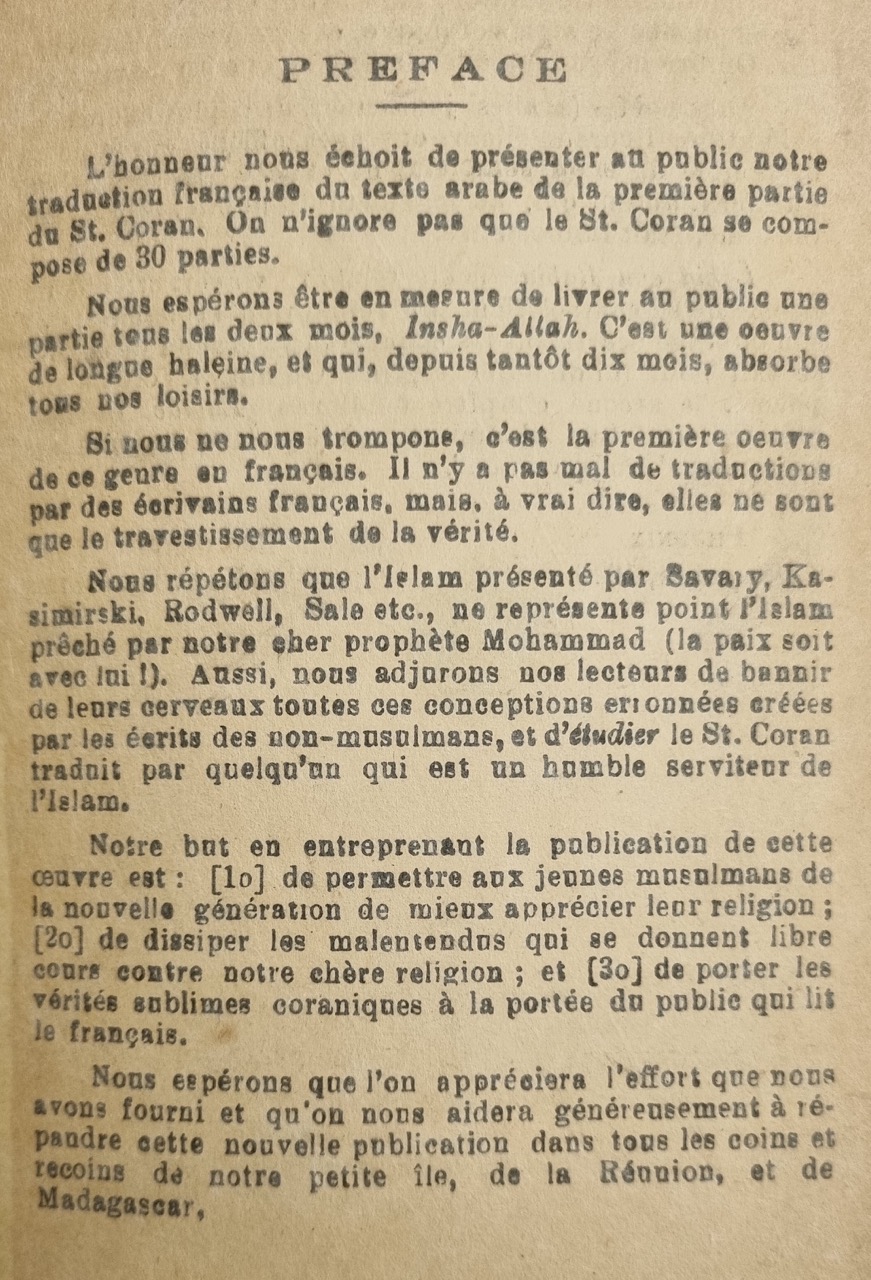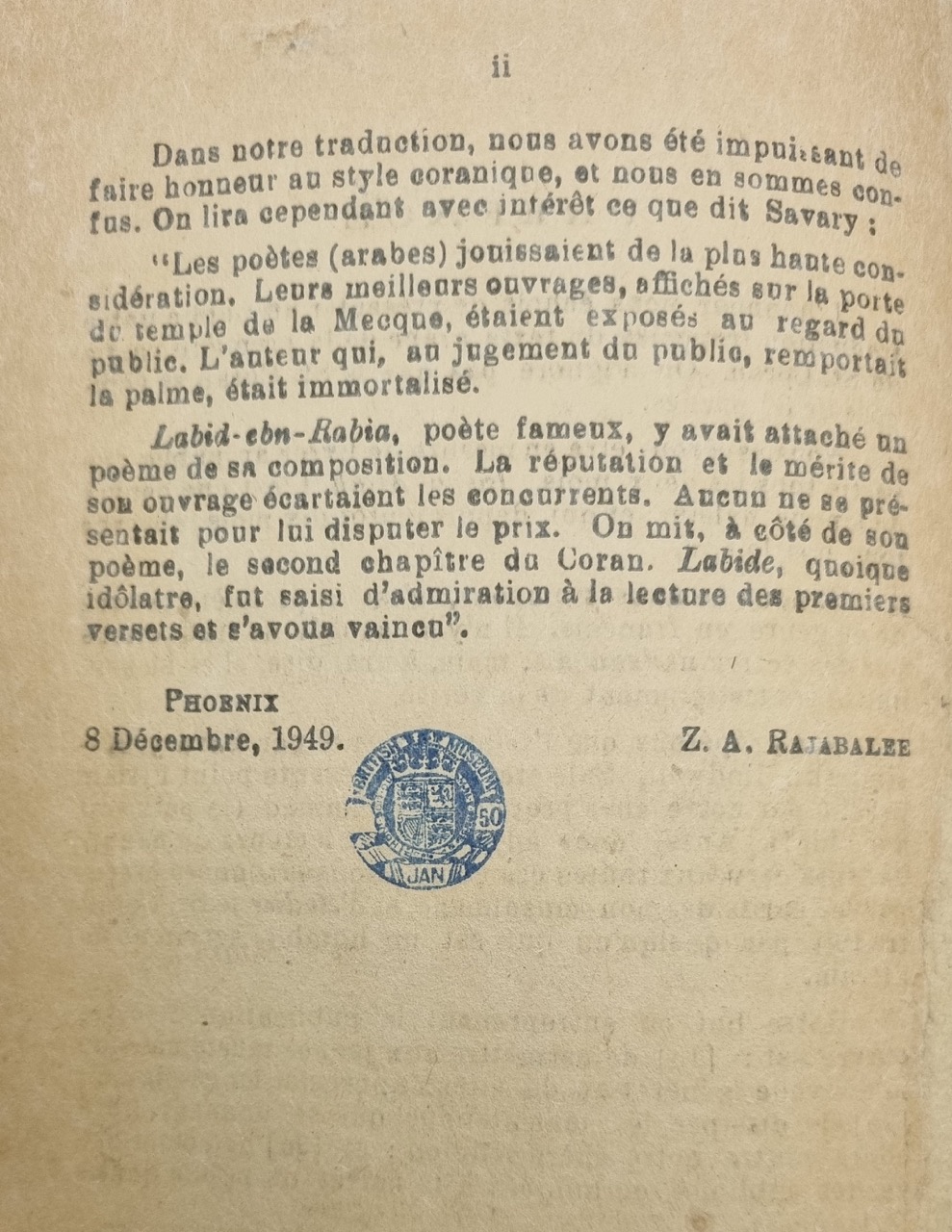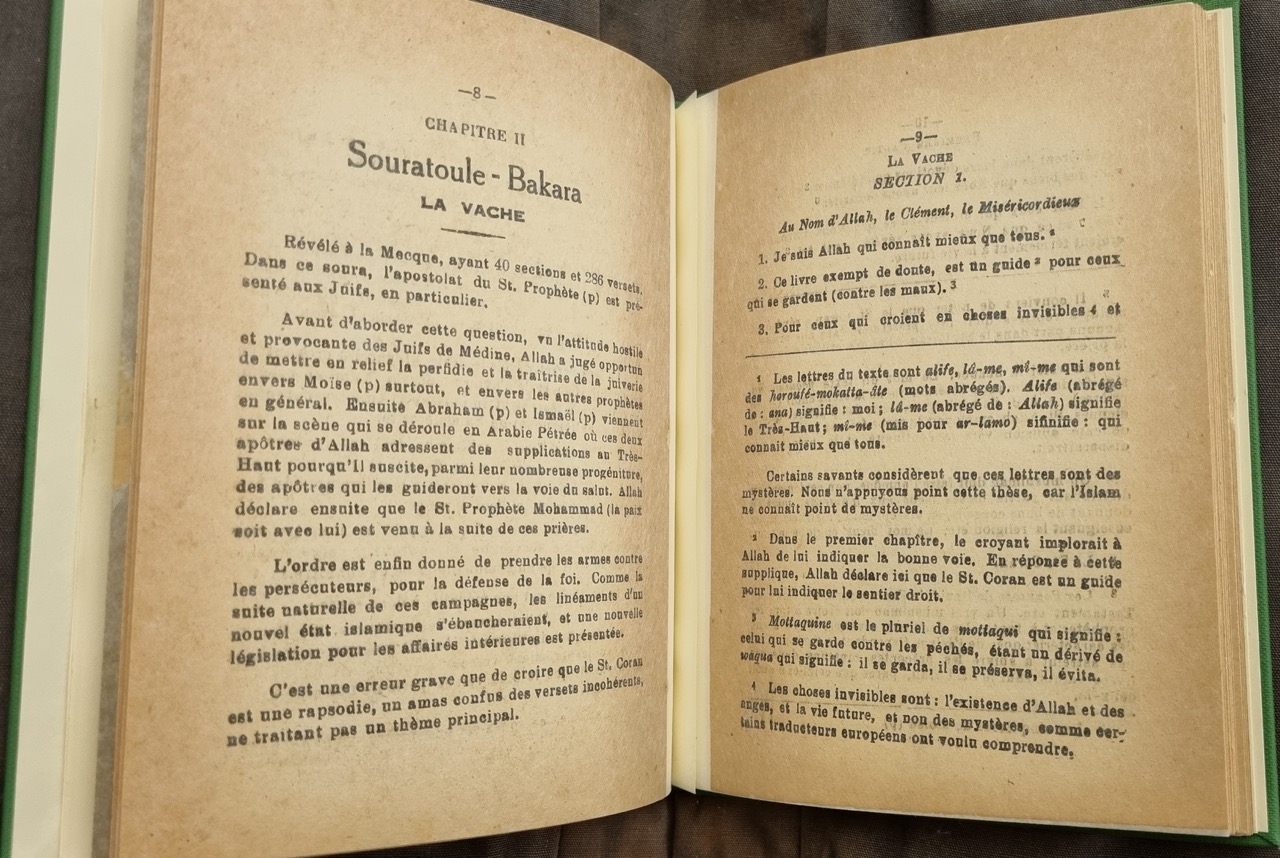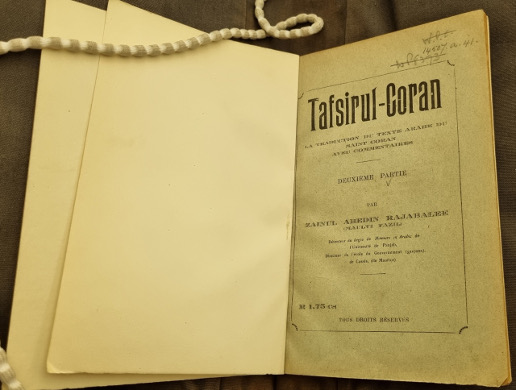In 1949, Zainul Abedin Rajabalee, a schoolmaster living on the Indian Ocean island of Mauritius, published the first part of his Qur’an translation. In the introduction, he wrote ‘If we are not mistaken, this is the first work of this kind in French’ – by which he meant the first to be written by a Muslim. He was, in fact, mistaken, since he was unaware of the complete French Qur’an translation by two Algerian Muslims published in 1931. His oversight is understandable because their work had remained relatively obscure, but not nearly as obscure as Rajabalee’s own effort was going to become. Not even the near-exhaustive list of translations that Muhammad Hamidullah included in the introduction to his 1959 French Qur’an translation makes mention of it. And yet, it is a fascinating testament of transcontinental interconnections, migration and multilingualism in the British Empire.


Mauritius had no native population before Europeans first landed there around 1500. It was successively colonized by the Dutch, the French and, from 1810, by the British. When Rajabalee wrote his work, it was still under British rule but French was still an important medium of communication. Almost the entire population was trilingual in Mauritian Kreol, English and French, and many knew even more languages than those three. This was especially true of the large number of immigrants from India, who often spoke Urdu and/or other Indian languages. They, or their forebears, had come to Mauritius as indentured laborers or merchants and nearly all Mauritian Muslims, who around 1950 probably constituted between fifteen to twenty percent of the population, belonged to this group of inhabitants. This includes Zainul Abedin Rajabalee.
We know nothing about Rajabalee, other than what he says about himself in his book. On the title page, he presents himself as a ‘Maulvi Fazil,’ the holder of an honors degree in Arabic from the University of Punjab. Obviously, he felt that his illustrious degree did not earn him sufficient respect, because he devoted the inner cover to the statement ‘On Mauritius, one seems to ignore the academic value of the degree of Maulvi Fazil’ followed by a description of the academic merits of the University of Punjab and of this particular degree. At the same time, he adorned the actual cover of his French translation with an English quotation from John Milton, ‘How sweet is divine philosophy!’ – a decision that is indicative of the diverse cultural and linguistic influences that left their traces on Mauritius. It also shows how successfully the British Empire had positioned early modern English literature – above all, Shakespeare and Milton – as the pinnacle of world literature.

Rajabalee lived in the town of Phoenix and was headmaster of the government school for boys in Mahébourg; about thirty kilometers from his home, and therefore nearly at the other side of the small island; some time between 1949 and 1951, he apparently took over the school of Cassis, a suburb of the capital city Port Louis. Apparently, his salary was not high, since he had problems funding the publication of his translation. ‘Tafsirul-Coran. La Traduction du texte Arabe du Saint Coran avec Commentaires’ was printed in French only, without the Arabic text, by Imprimerie Almadina in Port Louis, and Rajabalee paid for this himself. He asked readers to contact him for subscriptions and to hurry to obtain their copy before stock sold out because he would not be able to pay for a reprint. In the first volume, he announced his intention to publish one of the thirty parts of the Qur’an (juzʾ, pl. ajzāʾ) every other month. In fact, it took him two years, until 1951, to publish the second part, which ends after Q 2:252, and for which he had apparently received some small donations from fellow Mauritian Muslims that covered part of his costs. He expressed the hope that part three would soon follow but that hope never materialized.


Rajabalee was clearly driven by a strong motivation to spread the true message of Islam as he understood it. He criticized existing French and English Qur’an translations by non-Muslims such as Savary, Kasimirski, Rodwell and Sale for misrepresenting Islam, and was convinced that only ‘a humble servant of God’ could convey the meaning of the Qur’an correctly, even though he professed his inability to do justice to the stylistic power and expressive language of the Qur’an. He encouraged his readers to help spread his translation ‘in all corners of our little island, on Réunion and Madagascar.’ He also emphasized the importance of studying the legal content of the Qur’an, and therefore the relevance of his translation to Muslims who want to learn about repudiation – ‘this subject which is so complex and, at times, disconcerting’, the pilgrimage, Ramadan, jihad, menstruation, ‘strong liquors,’ the origin of the Ka’ba and ‘the Islamic principles for establishing international peace.’

When writing his Qur’an translation, Rajabalee presumably drew on the Arabic text of the Qur’an, which his education would have enabled him to understand, but also on a number of French and English translations. Some of those, such as those by Savary and Rodwell, he expressly and vehemently criticized in his extensive footnotes. The major source he used, however, is not mentioned at all, and that is the Qur’an translation by Muhammad Ali of the Lahore Ahmadiyya Movement, first published in England in 1917 and widely distributed across the British Empire and beyond. Rajabalee often followed Muhammad Ali’s choices, even when they are extremely idiosyncratic, and also paraphrased substantial parts of his commentary in his footnotes.



This is clear, for example, from his translation of Q 2:1, which consists of the three disjointed letters (muqaṭṭaʿāt) alif – lām – mīm, as ‘Je suis Allah qui connaît mieux que tous’ (‘I am Allah who knows better than anyone’). Nearly all other translators rendered this simply as ‘Alif – Lam – Mim’ or ‘ALM,’ whereas Muhammad Ali had translated it as ‘I am Allah, the best Knower.’ Rajabalee added a footnote that demonstrates why Muhammad Ali’s approach appealed to him: ‘Certain scholars think that these letters are mysterious. We do not support this claim because Islam does not contain mysteries.’
Muhammad Ali’s rationalistic attitude, and skepticism when it came to miracles, had already appealed to Muslims from China and the Dutch East Indies to the Turkish Republic and Western Europe, and it obviously sat well with Rajabelee, the teacher from Mauritius, too. For example, Q 2:55–56 is usually understood by exegetes as telling a story about Moses’ people, who told him they would never believe him until they saw God with their own eyes, whereupon they were struck by a thunderbolt or stroke of lightning (ṣāʿiqa) and then brought back to life from death (mawt). Muhammad Ali, however, unwilling to accept such a story that defied all laws of nature, rendered ṣāʿiqa vaguely as ‘punishment’ and mawt not as death but as ‘stupor,’ explaining that the Israelites momentarily swooned. Rajabalee completely follows him in this translation, although he tries to harmonize it somewhat with the traditional approach by explaining that the Israelites might have fainted as a result of being struck by lightning.
In Q 2:60, which alludes to another miracle story, Rajabalee pursues a different approach. This verse is typically understood as telling the story of how Moses struck a rock with his staff, whereupon twelve springs poured forth from it. Muhammad Ali, however, translated the segment iḍrib bi-ʿaṣāka l-ḥajara as ‘Seek with your staff a way into the mountain.’ Rajabalee apparently felt that this went too far and translated the segment in a far more conventional way as ‘frappe la pierre de ta canne’ (‘strike the rock with your staff’). He then went on to explain in a note that in mountain regions, water may be located directly under the surface and the miracle in this event exclusively consisted in the fact that God guided Moses to the exact place where this was the case. Thus, he does not deny the existence of miracles as such, but he does not think that God would violate the laws of nature in order to perform them either.
In many instances, he follows Muhammad Ali to the point of plagiarism, but always only up to a certain limit; he reproduces Muhammad Ali’s interpretation but not the sometimes rather far-reaching conclusions that Ali draws from them. For example, in his note on Q 2:62 (translated by Muhammad Ali as ‘Surely those who believe and those who are Jews, and the Christians, and the Sabians, whoever believes in Allah and the last day and does good, they shall have their reward from their Lord, and there is no fear for them, nor shall they grieve’), he faithfully summarizes Muhammad Ali’s explanation of who the Sabians are, but completely omits his discussion of the admission of non-Muslims to Paradise, which Muhammad Ali seems to consider possible even though he emphasizes the superiority of Islam.
A fundamental feature of Muhammad Ali’s approach that is apparent in a number of places in the first two parts of the Qur’an concerns the doctrine of abrogation (naskh). Muslim jurists usually argue that the Qur’an contains a certain number of conflicting verses in legal matters, for example with regard to the consumption of alcohol and matters of inheritance, and that in these cases, those verses that were revealed later abrogate the rulings of those verses that were revealed earlier. Muhammad Ali rejected this idea and instead understood the relevant verses in a way that precluded the existence of a conflict in the first place.
For instance, regarding alcohol, Q 2:219 says, in Muhammad Ali’s words, that in it, as well as in games of chance, ‘there is a great sin and means of profit for men, and their sin is greater than their profit.’ While exegetes commonly maintained that this verse was abrogated later by the prohibition of praying while intoxicated (Q 4:43) and then by the complete prohibition of alcohol (Q 5:90–91), Muhammad Ali argued that Q 2:219 already constituted a complete prohibition since any action that is more sinful than beneficial is automatically prohibited, and that the three verses are therefore not in conflict with each other at all. Rajabalee completely follows Muhammad Ali in his translation of the Arabic word khamar as ‘intoxicants,’ rather than ‘wine’ or ‘alcohol’ as can be more commonly found, and also copies a part of Muhammad Ali’s note. However, he does not mention the issue of abrogation at all, even though it was central to Muhammad Ali’s argument. The same is true for his position on inheritance. Muhammad Ali’s strategy here was to argue that Q 2:180 and Q 4:11, two verses that are often said to be abrogated (mansūkh) and abrogating (nāsikh) respectively, actually pertain to completely different topics. While the former verse addresses bequests for charitable purposes that are licit for up to one third of a person’s inheritance, the latter lays down the detailed rules of the division of inheritance among relatives. Again, Rajabalee faithfully follows Muhammad Ali in this interpretation but entirely omits his conclusion, namely, that the two verses are not in conflict with each other and there is therefore no need for one of them to abrogate the other.
As these examples show, Muhammad Ali’s translation was clearly the predominant source of Rajabalee’s translation and commentary, but Rajabalee did not follow him blindly or naively; he was very capable of distinguishing between interpretations that might be considered acceptable and those that might not, or that he simply did not accept himself. Moreover, in many cases he did not simply omit arguments from Muhammad Ali’s translation that he disagreed with but expressed his own ideas instead. Quite frequently these were of an apologetic nature, attacking previous Qur’an translations or what he considered to be common misconceptions about Islam. For example, in a note on Q 2:228, he delivers an impassioned attack against those who think that women – whom he calls ‘le sexe faible’ (‘the weaker sex’) – have no rights in Islam. In contrast to Muhammad Ali, who firmly declares that women have equal rights to men, Rajabalee goes on to explain: ‘Women have rights, just like men, but one will have to admit that the concentration of command in one person is essential in order to uphold order and harmony. In cases of dispute, man has the decisive voice, just as in the counting of votes in a committee the president generally has a casting vote [English in the original]. It would be childish to claim that the members of a committee do not enjoy any rights because the president has the decisive vote. Likewise, it would be extremely unfair to claim that a married woman enjoys no rights because the husband has a slight preeminence.’
Rajabalee’s Qur’an translation more or less fell into oblivion. He never completed it, had no distribution networks and obviously did not possess the means to ensure a large print run. Nevertheless, it is more than a curiosity. It was only the second French Qur’an translation by a Muslim (barring works that only presented a limited number of selected verses), and it was the very first Qur’an translation to be published in Mauritius, where in subsequent decades a number of further Qur’an translations into at least three languages (French, English and Kreol) were produced. It also bears witness to the unparalleled impact of Muhammad Ali’s Qur’an translation within and beyond the British Empire in the period between the 1920s and 1950s. That impact testifies to the transregional networks of the Ahmadiyya community and the success of a new paradigm of translating the Qur’an that Muhammad Ali had established. Finally, it throws into sharp relief the flow of goods, people and ideas from the Indian subcontinent that was crucial to the development of global Islam in the twentieth century, even though it does not always receive the attention it deserves.
Johanna Pink
